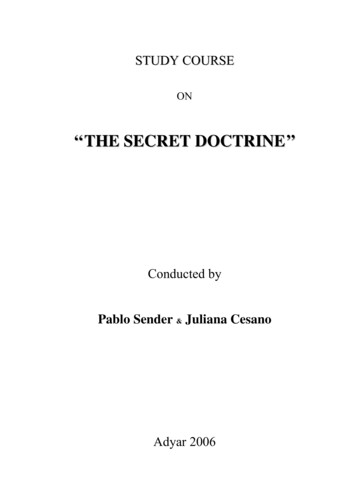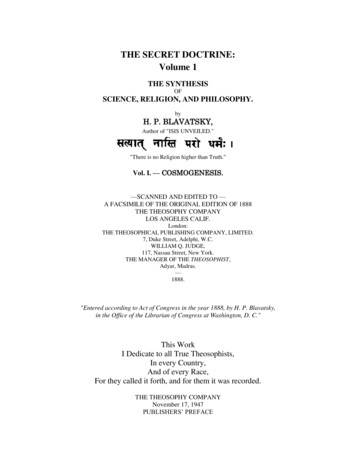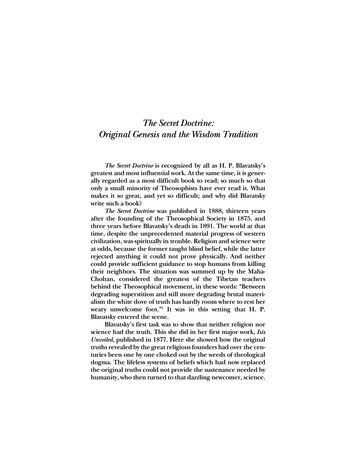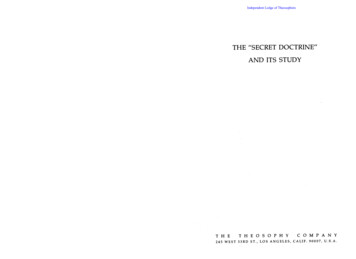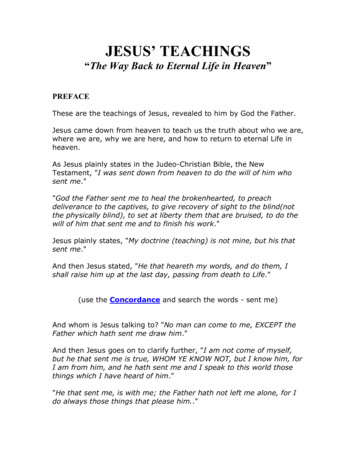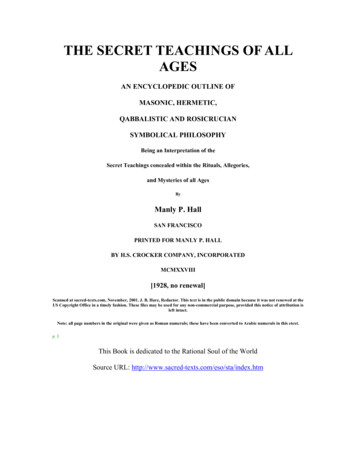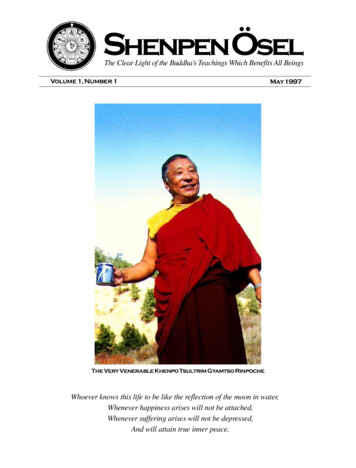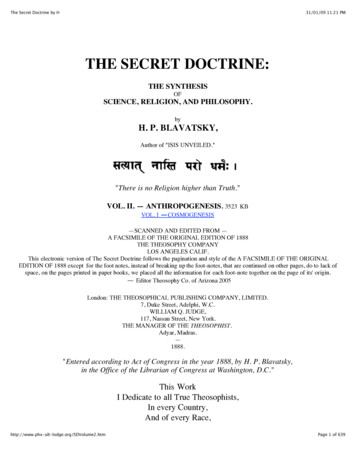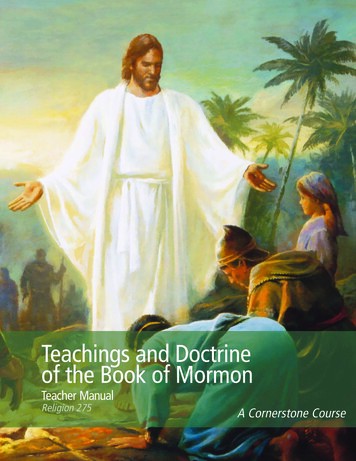
Transcription
Teachings and Doctrine of the Book ofMormon Teacher ManualReligion 275Published byThe Church of Jesus Christ of Latter-day SaintsSalt Lake City, Utah
Comments and corrections are appreciated. Please send them, including errors, to:Seminaries and Institutes of Religion Curriculum Services50 E. North Temple St., Floor 8Salt Lake City, Utah 84150-0008USAEmail: ces-manuals@ldschurch.orgPlease list your complete name, address, ward, and stake.Be sure to give the title of the manual. Then offer your comments. 2015 by Intellectual Reserve, Inc.All rights reserved.Printed in the United States of AmericaVersion 1, 9/15English approval: 8/14PD10052299
ContentsIntroduction to Teachings and Doctrine of the Book of Mormon Teacher Manual . . . v1The Book of Mormon Is Another Testament of Jesus Christ. . . . . . . . . . . .12Heeding the Words of Prophets3Obedience Brings Blessings . . . . . . . . . . . . . . . . . . . . . . . . . . . . . . . 94The Fall of Adam and the Gift of Agency . . . . . . . . . . . . . . . . . . . . . . 135The Infinite Atonement of Jesus Christ . . . . . . . . . . . . . . . . . . . . . . . 176The Book of Mormon Was Written for Our Day . . . . . . . . . . . . . . . . . . 217The Book of Mormon and the Bible . . . . . . . . . . . . . . . . . . . . . . . . . 258Salvation Comes through Jesus Christ . . . . . . . . . . . . . . . . . . . . . . . . 299“Seek Ye for the Kingdom of God”. . . . . . . . . . . . . . . . . . . . . . . . . . . .5. . . . . . . . . . . . . . . . . . . . . . . . . 3310Prayer and Revelation . . . . . . . . . . . . . . . . . . . . . . . . . . . . . . . . . 3711Protecting Ourselves against the False Doctrines of the Last Days12Our Need for Spiritual Rebirth . . . . . . . . . . . . . . . . . . . . . . . . . . . . 4613The Baptismal Covenant, the Sabbath, and the Sacrament . . . . . . . . . . . . 5014God’s Power of Deliverance . . . . . . . . . . . . . . . . . . . . . . . . . . . . . . 5415Becoming Instruments in the Hands of God . . . . . . . . . . . . . . . . . . . . 5816Repentance and Forgiveness . . . . . . . . . . . . . . . . . . . . . . . . . . . . . 6317The Power of the Word18Preparing for the Final Day of Judgment19Defending Religious Freedom20Strengthening Our Faith and Testimony21The Coming of Jesus Christ . . . . . . . . . . . . . . . . . . . . . . . . . . . . . . 8422“Even as I Am” . . . . . . . . . . . . . . . . . . . . . . . . . . . . . . . . . . . . . 8723The Scattering and Gathering of Israel24All Are Alike unto God25Living Righteously in a Day of Wickedness . . . . . . . . . . . . . . . . . . . . . 9926After the Trial of Faith . . . . . . . . . . . . . . . . . . . . . . . . . . . . . . . . 10327Faith, Hope, and Charity28Come unto Christ. . . . . . . 42. . . . . . . . . . . . . . . . . . . . . . . . . . . . . . . . 67. . . . . . . . . . . . . . . . . . . . . . 71. . . . . . . . . . . . . . . . . . . . . . . . . . . . 75. . . . . . . . . . . . . . . . . . . . . . 80. . . . . . . . . . . . . . . . . . . . . . . 91. . . . . . . . . . . . . . . . . . . . . . . . . . . . . . . . 95. . . . . . . . . . . . . . . . . . . . . . . . . . . . . . 107. . . . . . . . . . . . . . . . . . . . . . . . . . . . . . . . . . 111
Introduction to Teachings and Doctrineof the Book of Mormon TeacherManual (Religion 275)What is expected of a religion teacher?As you prepare to teach, it is important to understand the Objective of Seminaries andInstitutes of Religion:“Our purpose is to help youth and young adults understand and rely on the teachings and Atonementof Jesus Christ, qualify for the blessings of the temple, and prepare themselves, their families, andothers for eternal life with their Father in Heaven” (Gospel Teaching and Learning: A Handbook forTeachers and Leaders in Seminaries and Institutes of Religion [2012], x).You can achieve this purpose by diligently living the gospel, effectively teaching thegospel to your students, and appropriately administering your class or program. As youprepare and teach the gospel in these ways, you will qualify for the influence of theHoly Ghost (see D&C 42:14).It is your opportunity to help students learn by the Spirit so they can strengthen theirfaith and deepen their conversion. You can help students accomplish this as you leadthem to identify, understand, feel the truth and importance of, and apply significantdoctrines and principles of the gospel of Jesus Christ.The Gospel Teaching and Learning handbook is an essential resource for understandingthe teaching process and learning how to become successful in the classroom.What are the objectives and purposes of this course?It is anticipated that many institute-age students will have previously studied the Bookof Mormon sequentially—from beginning to end—at seminary, at home, or on amission. This course, Teachings and Doctrine of the Book of Mormon (Religion 275), isdesigned to help students use a different approach to studying the Book of Mormon.The lessons found in this course focus on prominent doctrinal themes emphasized bythe inspired authors of the Book of Mormon.President Ezra Taft Benson (1899–1994) invited readers of the Book of Mormon tocenter their attention on the doctrine it contains:“The Book of Mormon was written for our day. Not only should we know whathistory and faith-promoting stories it contains, but we should understand its teachings.If we really do our homework and approach the Book of Mormon doctrinally, we canexpose the errors and find the truths to combat many of the current false theories andphilosophies of men” (“Jesus Christ—Gifts and Expectations,” Ensign, Dec. 1988, 4).Throughout this course, students will study the prophetic writings and teachings foundin the Book of Mormon, with emphasis on Heavenly Father’s plan and the central roleof His Son, Jesus Christ. Students will better understand the Book of Mormon asanother witness of Jesus Christ and will deepen their love for and testimony of Him.They will improve their ability to study the doctrines of the gospel in their scripturalcontext, leading to greater understanding and personal discipleship. They will bev
INTRODUCTION TO TEACHINGS AND DOCTRINE OF THE BOOK OF MORMON TEACHER MANUAL (RELIGION 275)prepared to explain and testify of the importance and divine origin of the Book ofMormon and the doctrine it contains.What is expected of students?In order to receive credit toward institute graduation, students are required to read thescripture passages, general conference talks, and other materials listed in the StudentReadings section of each lesson. Students must also meet attendance requirementsand demonstrate competency with course material by completing an assessment.How are lessons structured in this manual?This course is designed as a semester-long course with 28 lessons written for50-minute class periods. If your class meets twice each week, teach one lesson eachclass period. If your class meets only once each week for 90 to 100 minutes, combineand teach two lessons each class period. Each lesson outline consists of four sections: Introduction Background Reading Suggestions for Teaching Student ReadingsIntroductionThis section provides a brief introduction to the topics and objectives of the lesson.Background ReadingThis section recommends resources, such as messages from latter-day prophets andother Church leaders, that can help you better understand the doctrines, principles,and gospel truths covered in the lesson outline.Suggestions for TeachingThe Suggestions for Teaching section includes material to help you know both what toteach and how to teach it (see also sections 4.3.3 and 4.3.4 in the Gospel Teaching andLearning handbook). Suggested learning activities are designed to help studentsidentify, understand, feel the truth and importance of, and apply sacred truths. Youmay choose to use some or all of the suggestions as you adapt them to fit yourindividual teaching style and to meet the needs and circumstances of your students. Asyou consider how to adapt lesson materials, follow this counsel from Elder Dallin H.Oaks of the Quorum of the Twelve Apostles:“President Packer has often taught, in my hearing, that we first adopt, then we adapt. Ifwe are thoroughly grounded in the prescribed lesson that we are to give, then we canfollow the Spirit to adapt it. But there is a temptation, when we speak about thisflexibility, to start off by adapting rather than adopting. It’s a balance. It’s a continualchallenge. But the approach of adopting first and then adapting is a good way to stayon sound ground” (“A Panel Discussion with Elder Dallin H. Oaks” [Seminaries and Institutes ofReligion satellite broadcast, Aug. 7, 2012], si.lds.org).This course includes statements by Church leaders that are likely to be available inmultiple languages. As you prepare to teach, you may adapt the lessons by using otheravailable statements by Church leaders that are relevant to the subject matter.vi
INTRODUCTION TO TEACHINGS AND DOCTRINE OF THE BOOK OF MORMON TEACHER MANUAL (RELIGION 275)The Suggestions for Teaching section contains at least one doctrine or principlestatement, which appears in bold. As students discover these doctrines and principlesand share what they have learned, their words may differ from those stated in themanual. When this happens, be careful not to imply that their answers are wrong.However, if a statement could be more accurate, carefully help clarify understanding.This curriculum demonstrates how to incorporate the fundamentals of gospel teachingand learning into a thematic course (see Gospel Teaching and Learning, 10, 23–31,38–41).Elder David A. Bednar of the Quorum of the Twelve Apostles described some of thebenefits that come from studying the gospel thematically:“Whereas reading a book of scripture from beginning to end provides a basic breadth ofknowledge, studying by topic increases the depth of our knowledge. Searching in therevelations for connections, patterns, and themes builds upon and adds to our spiritualknowledge ; it broadens our perspective and understanding of the plan of salvation.“In my judgment, diligently searching to discover connections, patterns, and themes ispart of what it means to ‘feast’ upon the words of Christ. This approach can open the floodgates ofthe spiritual reservoir, enlighten our understanding through His Spirit, and produce a depth ofgratitude for the holy scriptures and a degree of spiritual commitment that can be received in no otherway. Such searching enables us to build upon the rock of our Redeemer and to withstand the winds ofwickedness in these latter days” (“A Reservoir of Living Water” [Brigham Young University fireside,Feb. 4, 2007], 3, speeches.byu.edu).Student ReadingsThis section lists scripture passages, talks by Church leaders, and other materials thatwill enrich student understanding of the topics emphasized in the lessons. Assign andencourage students to read these materials before they come to each class. As theystudy these inspired materials, they will not only be better prepared to participate inclass discussions, but they will also gain broader and deeper understanding of coursetopics. Provide students with the list of all Student Readings at the beginning of thesemester.How can I prepare to teach?The Lord will assist you as you prepare to teach. As you prepare, you may find ithelpful to ask yourself the following questions: Am I striving to live the gospel worthily so I can be receptive to the Spirit in myteaching? Have I prayed to receive the guidance of the Holy Ghost? (See D&C 42:14.) Have I studied the assigned scripture blocks and background reading? Have I read the curriculum and determined if there is anything that I need to adaptor adjust to meet the needs of my students? How can I follow up with students to ensure that they are getting the most out ofassigned readings? How can I help each of my students fully participate in the lesson?The following recommendations may also be helpful:vii
INTRODUCTION TO TEACHINGS AND DOCTRINE OF THE BOOK OF MORMON TEACHER MANUAL (RELIGION 275) Encourage students to read assigned scripture passages and articles before eachclass. Expect students to fulfill their role as learners. Provide frequent opportunities for students to explain doctrines and principles intheir own words, share relevant experiences, and testify of what they know andfeel. Vary the learning activities and approaches you use in each class and also from dayto day. Create a learning environment that invites the Spirit and gives students theprivilege and responsibility to teach and to learn from one another (see D&C88:78, 122). Throughout the course there are references to scripture study skills. Take advantageof these opportunities to help students become more self-reliant in their scripturestudy and more dedicated to lifelong learning from the scriptures.Elder Richard G. Scott of the Quorum of the Twelve Apostles taught:“Assure that there is abundant participation because that use of agency by a studentauthorizes the Holy Ghost to instruct. As students verbalize truths, they areconfirmed in their souls and strengthen their personal testimonies” (“To Understandand Live Truth” [evening with Elder Richard G. Scott, Feb. 4, 2005], 3, si.lds.org).How can I adapt lessons for those with disabilities?As you prepare to teach, be mindful of students who have particular needs. Adjustactivities and expectations to help them succeed. Seek ways to help them feel loved,accepted, and included. Foster a relationship of trust.For more ideas and resources, consult the Disability Resources page atdisabilities.lds.org and the Seminaries and Institutes of Religion policy manual sectiontitled “Adapted Classes and Programs for Students with Disabilities.”viii
T E ACHIN G S AN D DO CT R IN E O F T HE B O O K O F MO R MO N —IN TRODUCTIONLesson TitleSuggested Readings12. Our Need forSpiritual Rebirth Mosiah 3:19; 5:1–5, 7–8; 16:2–5; 27:24 –26; Alma 5:14, 26–27; 41:10–11; Ether 12:27.David A. Bednar, “The Atonement and the Journey of Mortality,” Ensign, Apr. 2012, 40– 47.D. Todd Christofferson, “Born Again,” Ensign or Liahona, May 2008, 76–79.13. The BaptismalCovenant, theSabbath, andthe Sacrament Exodus 31:13, 16–17; Mosiah 18:8–10, 23; 25:23–24; 3 Nephi 18:1–11; 20:3–9; Moroni 4:3; 5:2; 6:4–6.Russell M. Nelson, “The Sabbath Is a Delight,” Ensign or Liahona, May 2015, 129–32. 1 Nephi 1:20; 6:4; Mosiah 7:33; 21:2–5, 14–16; 23:23–24; 24:13–15, 21; 29:20; Alma 34:9; 36:1–3,27–29; 58:10–11; Helaman 5:9; 3 Nephi 4:33.L. Tom Perry, “The Power of Deliverance,” Ensign or Liahona, May 2012, 94 –97.14. God’s Power ofDeliverance15. BecomingInstruments inthe Hands of God16. Repentance andForgiveness17. The Power ofthe Word 1 Nephi 13:37; Mosiah 15:14–19, 26–28; 28:3; Alma 17:2–3, 6, 9–12, 16, 25; 18:10, 33–35; 21:16;22:1, 12–14; 23:5–6; 26:2–5, 11–12, 15, 26–29; 29:9–10; 31:30–34.M. Russell Ballard, “Put Your Trust in the Lord,” Ensign or Liahona, Nov. 2013, 43– 45.Don R. Clarke, “Becoming Instruments in the Hands of God,” Ensign or Liahona, Nov. 2006, 97–99. Enos 1:4–8; Mosiah 4:1–3, 11–12, 26; Alma 19:29–30, 33–36; 34:15–17; 36:19–21; 3 Nephi 9:13–14, 19–22.Neil L. Andersen, “Repent . . . That I May Heal You,” Ensign or Liahona, Nov. 2009, 40– 43. 1 Nephi 3:19–20; 5:21–22; 8:21–24, 29–30; 15:23–24; 2 Nephi 3:12; 32:3; 33:4–5; Jacob 2:8; 7:10–11;Omni 1:14–17; Mosiah 1:3–5; Alma 5:10–13; 31:5; 37:2– 4, 8–10, 38– 46; Helaman 3:29–30; 15:7–8.Richard G. Scott, “The Power of Scripture,” Ensign or Liahona, Nov. 2011, 6–8. 18. Preparing forthe Final Dayof Judgment 2 Nephi 9:12–13; Mosiah 15:21–26; 16:6–11; Alma 5:15–21; 7:21–25; 11:40– 45; 16:6–11; 34:32–34;40:4 –7, 11–14, 19–24; 41:2–6.Dallin H. Oaks, “Resurrection,” Ensign, May 2000, 14 –16.19. Defending ReligiousFreedom Mosiah 29:10–11, 16–18, 25–26, 32; Alma 2:1–10, 12, 27–28; 30:7–9; 44:1–5; 46:4 –5, 10–16, 20–22.Robert D. Hales, “Preserving Agency, Protecting Religious Freedom,” Ensign or Liahona, May 2015, 111–13. 1 Nephi 15:7–11; 2 Nephi 1:10–11; 9:28; 25:28–29; 28:21–23; Mosiah 2:36–37; 4:11–12; 15:11; 26:1–4;Alma 12:9–11; Alma 31:8–11; 46:7–8; Helaman 4:11–13; 13:24 –26; 15:7–8; Mormon 5:16–18; 9:7–8.L. Whitney Clayton, “Choose to Believe,” Ensign or Liahona, May 2015, 36–39.Larry S. Kacher, “Trifle Not with Sacred Things,” Ensign or Liahona, Nov. 2014, 104 –6. Helaman 14:20–30; 16:1–5; 3 Nephi 9:1–5, 12–14; 10:12; 11:1–17.Dallin H. Oaks, “Preparation for the Second Coming,” Ensign or Liahona, May 2004, 7–10.Jeffrey R. Holland, “Preparing for the Second Coming,” New Era, Dec. 2013, 2–5. John 17:9–11, 20–23; 3 Nephi 12:1–16, 43– 45; 13:1, 5–7, 16–18, 22–24, 33; 14:1–5, 21–27;19:19–23, 28–29; 27:21–22, 27.Henry B. Eyring, “Our Perfect Example,” Ensign or Liahona, Nov. 2009, 70–73. 1 Nephi 15:12–16; 22:3–5, 8–12; 2 Nephi 25:15–17; 3 Nephi 5:24–26; 16:4–5; 20:13, 29–31; 21:1–7; 30:2.Russell M. Nelson, “The Gathering of Scattered Israel,” Ensign or Liahona, Nov. 2006, 79–82. 2 Nephi 26:23–28, 33; Jacob 7:24; Enos 1:11, 20; Mosiah 28:1–3; Alma 27:1–2, 20–24; 53:10–11, 13–17;Helaman 6:1–8; 4 Nephi 1:1–3, 11–13, 15–18.Dallin H. Oaks, “All Men Everywhere,” Ensign or Liahona, May 2006, 77–80.20. Strengthening OurFaith and Testimony21. The Coming ofJesus Christ22. “Even as I Am”23. The Scattering andGathering of Israel24. All Are Alikeunto God Alma 37:21–22, 25–27; 62:41; Helaman 6:20–26, 37– 40; 4 Nephi 1:42; Mormon 1:13–17, 19;2:8, 14 –15, 18–19; 3:2–3, 12, 22; Ether 8:18–26; Moroni 9:6, 22, 25–26.Quentin L. Cook, “Reaping the Rewards of Righteousness,” Ensign, July 2015, 33–39.26. After the Trialof Faith 2 Nephi 27:23; 3 Nephi 17:5–9, 20–24; Mormon 9:9, 18–20; Ether 3:6–13, 17–20; 4:13–15; 12:6–7, 12, 19, 31.David A. Bednar, “Ask in Faith,” Ensign or Liahona, May 2008, 94 –97.Neil L. Andersen, “You Know Enough,” Ensign or Liahona, Nov. 2008, 13–14.27. Faith, Hope,and Charity Alma 32:26–29, 37– 41; Ether 12:4, 8–9, 28, 33–34; Moroni 7:21, 25–28, 33, 40– 48; 10:18–21.Dieter F. Uchtdorf, “The Infinite Power of Hope,” Ensign or Liahona, Nov. 2008, 21–24.Richard G. Scott, “The Transforming Power of Faith and Character,” Ensign or Liahona, Nov. 2010, 43–46.28. Come unto Christ 1 Nephi 6:4; Jacob 1:7; Omni 1:26; 3 Nephi 9:13–14; Moroni 7:18–26; 10:3–5, 30, 32–33.“A Christ-Centered Life,” chapter 24 in Teachings of Presidents of the Church: Ezra Taft Benson (2014), 297–306.25. Living Righteously ina Day of Wickedness
The Book of Mormon IsAnother Testament of JesusChristIntroductionThose who study the teachings and doctrine of the Book ofMormon will come to know that Jesus is the Christ. In this lesson,students will learn that the book’s major authors were1eyewitnesses of the Son of God and that their words help deepenour understanding and testimony of Jesus Christ and His gospel.Background Reading Gordon B. Hinckley, “A Testimony Vibrant and True,” Ensign, Aug. 2005, 2–6. “The Book of Mormon—Keystone of Our Religion,” chapter 9 in Teachings ofPresidents of the Church: Ezra Taft Benson (2014), 125–35.Suggestions for Teaching1 Nephi 13:40; 2 Nephi 25:17–18; Alma 33:22–23The Book of Mormon is a testament of Jesus ChristDisplay the following statement by the Prophet Joseph Smith (1805–44), and ask astudent to read it aloud:“I told the brethren that the Book of Mormon was the most correct of any book onearth, and the keystone of our religion, and a man would get nearer to God by abidingby its precepts, than by any other book” (introduction to the Book of Mormon). Which of the Prophet’s assertions about the Book of Mormon do you have atestimony of, and why? How does the Prophet’s statement increase your motivation to study the Book ofMormon?Invite students to highlight this statement in their own scriptures in the sixthparagraph of the introduction to the Book of Mormon, and suggest that they write nextto it cross-references to 1 Nephi 13:40 and 2 Nephi 25:17–18. (Note: Cross-referencingis a scripture study skill that you might choose to emphasize throughout this course.As students strengthen their scripture study skills, they become more spiritually selfreliant.)Invite a few students to take turns reading aloud from 1 Nephi 13:40 and 2 Nephi25:17–18 while the class looks for a primary purpose of the Book of Mormon. According to these verses, what is one of the primary purposes of the Book ofMormon? (Students should identify the following truth: God brought forth theBook of Mormon in the last days to convince all people that Jesus is theChrist. [See also the title page of the Book of Mormon.]) How does the Book of Mormon convince people that Jesus is the Christ?1
LESSON 1: THE BOOK OF MORMON IS ANOTHER TESTAMENT OF JESUS CHRISTDisplay the following statement by President Ezra Taft Benson (1899–1994), and invitestudents to read it silently:“Much of the Christian world today rejects the divinity of the Savior. They question Hismiraculous birth, His perfect life, and the reality of His glorious resurrection. The Book ofMormon teaches in plain and unmistakable terms about the truth of all of those. It alsoprovides the most complete explanation of the doctrine of the Atonement. Truly, thisdivinely inspired book is a keystone in bearing witness to the world that Jesus is theChrist” (Teachings of Presidents of the Church: Ezra Taft Benson [2014], 129–30). What are some realities of Jesus Christ’s life and ministry that are confirmed in theBook of Mormon?Invite a student to read aloud the following statement by President Russell M. Nelsonof the Quorum of the Twelve Apostles:“I have read [the Book of Mormon] many times. I have also read much that has beenwritten about it. Some authors have focused upon its stories, its people, or its vignettesof history. Others have been intrigued by its language structure or its records ofweapons, geography, animal life, techniques of building, or systems of weights andmeasures.“Interesting as these matters may be, study of the Book of Mormon is most rewarding when onefocuses on its primary purpose—to testify of Jesus Christ. By comparison, all other issues areincidental.“When you read the Book of Mormon, concentrate on the principal figure in the book—from its firstchapter to the last—the Lord Jesus Christ, Son of the Living God” (“A Testimony of the Book ofMormon,” Ensign, Nov. 1999, 69). Of all the messages of the Book of Mormon, why do you think it is most importantto focus on the message about Jesus Christ?Explain to students that after the prophet Alma taught the Zoramites about theSavior’s ministry (see Alma 33:22), he invited his listeners to plant God’s word in theirhearts so that it might grow. Invite students to silently read Alma 33:22–23 and identifythe truths that Alma encouraged his readers to “plant” in their hearts. What was the message that Alma wanted his hearers to plant in their hearts? What results did Alma promise if they would plant and nourish these beliefs aboutJesus Christ? (Their testimonies would grow “unto everlasting life”; their burdenswould be light.) How has studying the Book of Mormon helped you receive the blessings Almadescribes?1 Nephi 6:4; 2 Nephi 11:2–3; Jacob 1:7–8; Mormon 1:15; 3:20–22; Ether12:38–39, 41Book of Mormon writers were eyewitnesses of Jesus ChristExplain that the Book of Mormon was largely written by four main authors: Nephi,Jacob, Mormon, and Moroni. (Exceptions are the books of Enos, Jarom, and Omni.)Put the following chart on the board. To help students learn about these four mainwriters, invite them to select and silently read one of the following passages. Ask themto look for what qualified the writer to be a powerful witness of Jesus Christ.2
LESSON 1: THE BOOK OF MORMON IS ANOTHER TESTAMENT OF JESUS CHRISTWriterExperience1. Nephi2 Nephi 11:22. Jacob2 Nephi 11:33. MormonMormon 1:154. MoroniEther 12:38–39Allow students to share what they learned from each of the four passages. Then ask: Why is it important to understand that the major writers of the Book of Mormonwere eyewitnesses of Jesus Christ? (As you discuss this question, help studentsidentify the following truth: By studying the Book of Mormon, we learn aboutJesus Christ and His mission from those who saw and knew Him. You mightpoint out that the translator of the Book of Mormon, Joseph Smith, was also aneyewitness of Jesus Christ.)Add a third column to the chart on the board, as shown:WriterExperiencePurpose1. Nephi2 Nephi 11:21 Nephi 6:42. Jacob2 Nephi 11:3Jacob 1:7–83. MormonMormon 1:15Mormon 3:20–224. MoroniEther 12:38–39Ether 12:41Ask each student to silently read one of the passages in the third column, looking forthe reasons each writer recorded his message. Why did these Book of Mormon writers record their messages? Why do you think these writers were so intent on inviting others to come untoChrist? How do their invitations to come unto Christ apply to you personally? Whatthoughts and feelings do you have as you ponder these invitations?2 Nephi 33:1–2, 4–5, 10–11The Book of Mormon helps us to believe in Jesus ChristExplain that while the lives of countless individuals have been changed through theirtestimonies of the Book of Mormon, others struggle with doubts about its truthfulnessand authenticity. What advice would you give to help someone strengthen or gain a testimony of theBook of Mormon?3
LESSON 1: THE BOOK OF MORMON IS ANOTHER TESTAMENT OF JESUS CHRISTAsk a student to read 2 Nephi 33:1–2 aloud while the class identifies the power thatallows the message of the Book of Mormon to enter one’s heart. What power did Nephi say would allow his message to enter a person’s heart? (Thepower of the Holy Ghost.) What did Nephi say would prevent some people from receiving the Holy Ghost?Invite students to state and discuss a principle taught in these verses. (Help studentsidentify the following principle: The Holy Ghost can carry the message of the Bookof Mormon into our hearts as long as we do not harden our hearts against theHoly Ghost. Consider writing this principle on the board.)Give students a moment to study 2 Nephi 33:4–5, looking for additional blessings thatwe can receive from studying the Book of Mormon. Ask students to share what theyidentified.Display the following statement by Elder L. Whitney Clayton of the Seventy, and ask astudent to read it aloud:“[We] must choose to open our hearts to the divine reality of the Savior. God doesnot force us to believe. Instead He invites us to believe by sending living prophets andapostles to teach us, by providing scriptures, and by beckoning to us through His Spirit. The decision to believe is the most important choice we ever make. It shapes all ourother decisions” (“Choose to Believe,” Ensign or Liahona, May 2015, 38). How can accepting the invitation of the Book of Mormon writers to believe in JesusChrist shape all our other decisions?Continue by inviting a student to read 2 Nephi 33:10–11 aloud while the class looks forhow Nephi describes the relationship between believing in his words and believing inJesus Christ. According to Nephi, what is the relationship between believing in his words andbelieving in Jesus Christ? What did Nephi say would happen “at the last day” to those who reject his words?Invite students to share their testimonies of how the Book of Mormon has helpedthem draw closer to Jesus Christ.Student Readings 1 Nephi 6:4; 13:40; 2 Nephi 11:2–3; 25:17–18; 33:1–2, 4–5, 10–11; Jacob 1:7–8; Alma33:22–23; Mormon 1:15; 3:20–22; Ether 12:38–39, 41. “The Book of Mormon—Keystone of Our Religion,” chapter 9 in Teachings ofPresidents of the Church: Ezra Taft Benson (2014), 125–35.4
Heeding the Words of ProphetsIntroductionGod calls prophets to bear witness of Jesus Christ, to declarerepentance, and to invite all to come unto the Savior. The Book of2Mormon teaches that those who heed these prophets are blessed,while those who oppose them experience regret and sorrow.Background Reading Russell M. Nelson, “Sustaining the Prophets,” Ensign or Liahona, Nov. 2014, 74–77. Claudio R. M. Costa, “Obedience to the Prophets,” Ensign or Liahona, Nov. 2010,11–13. Carol F. McConkie, “Live according to the Words of the Prophets,” Ensign orLiahona, Nov. 2014, 77–79. “Our Need for Living Prophets,” chapter 1 in Teachings of the Living ProphetsStudent Manual (Church Educational System manual, 2010), 4–13.Suggestions for Teaching1 Nephi 1:4–15, 18; Mosiah 11:20–25; 13:33–35The role of prophetsAsk the class: How does our belief in a living prophet distinguish The Church of Jesus Christ ofLatter-day Saints from other faiths? Why are living prophets as necessary today as they were in other periods of earth’shistory?Invite several students to take turns reading aloud from 1 Nephi 1:4–15, 18 while theclass follows along, looking for how the Lord called and prepared Lehi to be a prophet. What did Lehi experience that prepared him to be a prophet? (He received awitness of Jesus Christ, and he foresaw the destruction of the wicked and the mercygranted to those who come unto God.) Why did the people of Jerusalem need prophets like Lehi? (As students respond,make sure they identify this truth: God calls prophets and reveals His willthrough them.)Invite a student to read the following statement by President John Taylor (1808–87):“We require a living tree—a living fountain—living intelligence, proceeding from theliving priesthood in heaven, through the living priesthood on the earth. And from thetime that Adam first received a communication from God, to the time that John, on theIsle of Patmos, received his communication, or Joseph Smith had the heavens opened tohim, it always required new revelations, adapted to the peculiar circumstances in whichthe churches or individuals were placed.“Adam’s revelation did not instruct Noah to build his ark; nor did Noah’s revelation tell Lot to forsakeSodom; nor did either of these speak of the departure of the
It is anticipated that many institute-age students will have previously studied the Book of Mormon sequentially—from beginning to end—at seminary, at home, or on a mission. This course, Teachings and Doctrine of the Book of Mormon (Religion 275), is designed to help students use a different approach to studying the Book of Mormon.
